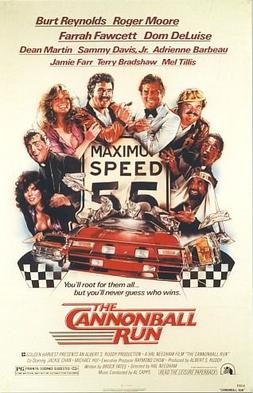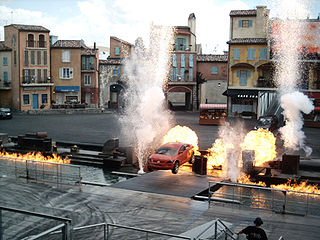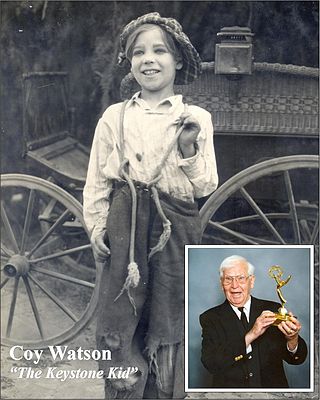
Terrence Stephen McQueen was an American actor and racing driver. His antihero persona, emphasized during the height of the counterculture of the 1960s, made him a top box-office draw for his films of the 1960s and 1970s. He was nicknamed the "King of Cool" and used the alias Harvey Mushman in motor races.

A stunt is an unusual, difficult, dramatic physical feat that may require a special skill, performed for artistic purposes usually for a public audience, as on television or in theaters or cinema. Stunts are a feature of many action films. Before computer-generated imagery special effects, these depictions were limited to the use of models, false perspective and other in-camera effects, unless the creator could find someone willing to carry them out, even such dangerous acts as jumping from car to car in motion or hanging from the edge of a skyscraper: the stunt performer or stunt double.

A stunt performer, often called a stuntman or stuntwoman and occasionally stuntperson or stunt-person, is a trained professional who performs daring acts, often as a career. Stunt performers usually appear in films or on television, as opposed to a daredevil, who performs for a live audience. When they take the place of another actor, they are known as stunt doubles.

The Cannonball Run is a 1981 action comedy film. It was directed by Hal Needham, produced by Hong Kong's Golden Harvest films, and distributed by 20th Century-Fox. Filmed in Panavision, it features an all-star ensemble cast, including Burt Reynolds, Dom DeLuise, Roger Moore, Farrah Fawcett, Jackie Chan and Dean Martin. The film is based on the 1979 running of the Cannonball Baker Sea-to-Shining-Sea Memorial Trophy Dash, an actual cross-country outlaw road race beginning in Connecticut and ending in California.

Hal Brett Needham was an American stuntman, film director, actor, writer, and NASCAR team owner. He is best known for his frequent collaborations with actor Burt Reynolds, usually in films involving fast cars, such as Smokey and the Bandit (1977), Hooper (1978), The Cannonball Run (1981) and Stroker Ace (1983).

Riverside International Raceway was a motorsports race track and road course established in the Edgemont area of Riverside County, California, just east of the city limits of Riverside and 50 mi (80 km) east of Los Angeles, in 1957. In 1984, the raceway became part of the newly incorporated city of Moreno Valley. Riverside was noted for its hot, dusty environment and for being somewhat of a complicated and dangerous track for drivers. It was also considered one of the finest tracks in the United States. The track was in operation from September 22, 1957, to July 2, 1989, with the last race, The Budweiser 400, won by Rusty Wallace, held in 1988. After that final race, a shortened version of the circuit was kept open for car clubs and special events until 1989.
William Carey Loftin was an American professional stuntman, stunt coordinator and actor in the U.S. film industry. He is considered to be one of the film industry's most accomplished stunt drivers. In a lengthy career spanning 61 years, his body of work included classic films such as Thunder Road, Bullitt, Vanishing Point, Duel, and The French Connection. He was posthumously inducted into the AMA Motorcycle Hall of Fame in 2001.

The Lights, Motors, Action!: Extreme Stunt Show, was a stunt show performed at Walt Disney Studios Park in Disneyland Paris and at Disney's Hollywood Studios theme park in Lake Buena Vista, Florida. The show was designed to be and look like a movie set, and the show is dedicated to show the process of how action movies are created.

Maurice William Elias, known professionally as James Stacy, was an American film and television actor who starred in the late 1960s TV western Lancer.

William Hickman was an American professional stunt driver, stunt coordinator and actor in the U.S. film industry. His film career spanned from the 1950s through to the late 1970s, and included films such as Bullitt, The French Connection and The Seven-Ups.

James Caughey Watson Jr., professionally known as Coy Watson, was an American child actor of the silent era, who was from an extended family of nine siblings of fellow performers known as The Watson Family. He appeared in more than 60 films.
James Sherwin "Bud" Ekins was an American professional stuntman in the U.S. film industry. He is considered to be one of the film industry's most accomplished stuntmen with a body of work that includes classic films such as The Great Escape and Bullitt. Ekins, acting as stunt double for Steve McQueen while filming The Great Escape, was the rider who performed what is considered to be one of the most famous motorcycle stunts ever performed in a movie. He was recognized for his stunt work by being inducted into the Stuntmen's Hall of Fame.
Edward Dean Jeffries was an American custom car designer and fabricator, as well as stuntman and stunt coordinator for motion pictures and television programs based in Los Angeles, California.

Harry Brannon was an American popular singer born in Gloucester City, New Jersey.

Stan Barrett is a Hollywood stuntman, stunt coordinator actor, and former stock car racing driver. His biggest act was however outside the movie world. On December 17, 1979, he attempted to break the land speed record, and the sound barrier in the Budweiser Rocket rocket-powered three-wheel vehicle. His calculated speed was 739.666 miles per hour,, which would have made Barrett the first man to break the sound barrier in a land vehicle. The attempt was surrounded by controversy and the speed was never officially recorded. Barrett also raced in 19 Winston Cup Series races between 1980 and 1990, posting two top ten finishes.
Alan Scott Newman was an American film and television actor and stuntman whose most prominent roles were in The Towering Inferno and Breakheart Pass. He was the only son and the eldest child of actor Paul Newman. After Scott Newman's death from a drug overdose in 1978, his father established the Scott Newman Center, which is dedicated to preventing drug abuse through education.
Harry Redmond Jr. was an American special effects artist and film producer whose career spanned decades in the entertainment industry. Redmond was the husband of the late production designer and illustrator, Dorothea Holt Redmond, who helped design Main Street in Disneyland and the Seattle Space Needle.

A racing helmet is a form of protective headgear worn by racing car and rally drivers. Motor racing has long been known to be an exceptionally risky sport: sudden deceleration forces on the head can easily occur if a racing car loses control at the very high speeds of competitive motor racing or the rough terrain experienced in rallying. A risk more nearly unique to motor racing is the possibility of drastically severe burns from fuel igniting when the fuel lines or fuel tank of the vehicle are jolted sufficiently to dislodge or breach them in a situation in which the driver cannot soon enough escape from his car. This happened to world champion driver Niki Lauda at the 1976 German Grand Prix race at the Nürburgring in a crash from which he barely escaped alive.
Bob Rose was an American actor and stuntman.












